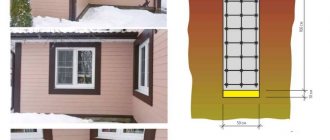Despite the apparent disadvantages of apartments on the ground floors (noise on the street, a high probability of theft, etc.), there is still an advantage of living on the ground floor - the opportunity to expand your living space by constructing an extension - a part of the building located outside the contour of the main external walls
But building an additional room/bedroom/veranda, etc. is not so easy, because first you need to legalize such construction.
How to legalize an extension to an apartment building in 2020, what is the procedure?
Step-by-step process for registering an extension to an apartment building
Many citizens do not know where to start the procedure for legalizing an extension or how to register an extension.
Documentation must be completed in any case - if construction of the extension has just begun and if part of the building has already been erected.
The procedure is as follows:
Step 1. Preparing documents
The owner of the apartment should collect the following documents for the apartment to which he plans to make an extension:
- construction project (must be ordered from designers);
- apartment plan;
- extract from the house register;
- certificate from the BTI;
- a document confirming ownership of the apartment (purchase and sale agreement, donation agreement, etc.);
- permission from the Rospotrebnadzor authority to draw up a construction plan in accordance with sanitary standards and rules;
- permission from the fire safety service;
- consent to legitimize the extension from the Committee of Architecture and Urban Planning;
- consent of neighbors to build part of a structure for an apartment building.
If necessary, additional documents will be required - acts from utility services on the availability of communications, photographs of an apartment building, etc.
Step 2. Obtaining permission to build a building
To begin the legalization procedure, you must obtain permission to add a balcony on the first floor of an apartment building. Where and how to obtain permission to build an extension to an apartment building? You need to contact the local government authority, namely the architectural department .
Within 30 days, employees of this department must review the submitted application and make a decision on it - to issue a construction permit or not.
If the applicant is refused permission, then he has the right to go to court with a statement of claim and the necessary package of documents for the apartment, as well as for the planned construction.
If the judge determines that the refusal to issue a permit is illegal, then the owner of the apartment, along with the court opinion, will be able to go to the BTI and register the extension.
But there are very few cases where the judge made the opposite decision. Usually judges make decisions not in favor of the owners, since very often people build extensions without complying with the rules and regulations.
And if the structure has already been erected, and the local administration authorities refuse to give permission, then in the end the competent authorities will have the right to demolish such an extension . Therefore, experts recommend that you first design an extension to an apartment building on the ground floor, and only then engage in construction.
Step 3. Construction work
If the local authority's architecture department has issued the applicant with a building permit along with a plan, then it's time to start building the extension.
It is imperative that construction be carried out with the permission of the gas service, Gorvodokanal, and electrical networks.
Step 4. Delivery of the object
When all work to legitimize the extension is completed, the owner of the apartment to which the additional building belongs must issue an acceptance certificate for the object with the contractor who carried out the construction work.
If the extension was erected by the owner of the living space himself, then the commission should include employees of utility services, a design company, and a representative of the local administration.
Step 5. Preparation of documents for the newly erected extension
If the commission determines that the structure complies with all construction and sanitary standards, then the owner will need to apply to the BTI to obtain a new technical passport, and then to Rosreestr to make changes to the Unified State Register of Registration (USRN) extract.
We prepare documents
Documentation for the attached part may be necessary in two cases:
- Construction is just beginning;
- Everything has already been built, and illegally.
Typically, all extensions are divided into 2 types:
- Objects of non-permanent construction - buildings without a foundation or structures that are easy to assemble/disassemble without erecting additional walls (these are canopies, stairs protruding a maximum of 12 m). In this case, there is no need to obtain special permissions, nor the consent of neighbors. You can simply issue an act of refurbishment of the premises.
- Capital buildings are objects that can affect those. characteristics and somehow change the infrastructure of the entire house (balconies and verandas built on the ground floor). This type of premises requires a permit.
For capital buildings, it is important to prepare the following documents:
- Permission from all residents of the house. You need to go around all the apartments in your building so that the owners sign (that they are not against the extension);
- Premises design;
- Documentation confirming clear ownership;
- General plan of the premises;
- Permission from Rospotrebnadzor;
- Official permission from firefighters and the Architecture Committee.
Has the construction work been completed? It is important to draw up an acceptance certificate. The acceptance committee must sign it.
Its composition is as follows: the owner of the apartment, utility workers, an employee of the design company and at least one representative of the administration.
Immediately after all persons have signed the act, it is worth ordering an official registration certificate from the BTI, as well as quickly making changes to the certificate for the existing apartment.
If the building is already built in, in order to formalize it, you will need to collect the following documents:
- Papers confirming your ownership of real estate;
- An extract made from the house register;
- Permission from the BTI;
- Written consent of all neighbors for your construction;
- Prepared acts regarding the presence/absence of nearby communications;
- Project and detailed plan of the premises, which are already built-in;
- Photo of the house.
An example of how to draw up documents is not difficult to find on the Internet.
How to legalize an extension if it has been built a long time ago?
If the owner of the apartment unauthorizedly erected an extension without obtaining a building permit and without the consent of all neighbors, then according to Art. 222 of the Civil Code of the Russian Federation, such an extension is subject to demolition.
In some cases, the extension may be left, but only if:
- the building complies with all construction rules and regulations;
- the erected structure does not violate the rights and interests of other persons (not only neighbors, but also other people who may be disturbed by the extension in some way);
- the extension does not threaten the life and health of people.
If the extension was erected without permits and approvals, that is, without permission, then the person to whom it supposedly belongs will not have any rights to it. This means that he will not be able to sell it, donate it, bequeath it, or perform any other actions with it, since legally the building does not belong to him.
If the extension has already been built, then it is still possible to legalize it, but it will be much more difficult . First, you need to again go to the architectural department at the local municipality and get urban planning conditions.
If there are any documents for the construction (for example, a certificate of completion of work, contracts, expert opinion, design documentation), then you also need to take them with you. Within a month, the created commission reviews the applicant’s appeal and makes a decision whether to grant permission for legalization or not.
If approval is received, then the owner must contact utility organizations - gas service, water supply, energy supply, fire organization to approve the erected structure.
He must also obtain the consent of all owners of the apartment building that they are not against the extension. And only when everything is agreed upon and the documents are ready, then the owner of the premises can confirm ownership of the extension.
Terms of approvals
The terms of survey and design for the upcoming extension are determined by agreement. They depend on the terms of the technical specifications, the features of the upcoming work and the characteristics of the original object. Review of documents by Gosstroynadzor takes no more than 7 days. After completion of the work, the technical plan can be obtained from our company within 1-5 days. More information about the timing of procedures and registration of mandatory documents can be found by calling us.
| No. | Service, document | Price |
| 1 | Development of a reconstruction project | from 350 rub./sq.m. (depending on the total area of the building) |
| 2 | Examination of design documentation | Calculated according to Decree No. 415, depends on the type of project, type and area of the building |
| 3 | Support of approval and obtaining permits at Gosstroynadzor | from 30,000 rub. |
| 4 | Support of cadastral registration and registration | from 15,000 rub. |
| 5 | Conducting engineering surveys and site inspections | from 30,000 rub. per hectare of land. |
Reasons for refusal to legalize an extension to an apartment building
The reasons for refusing to legalize an extension even at the stage of its construction may be the following circumstances:
- if the apartment building is an architectural value, a monument;
- if the neighbors are against an extension to their house;
- if the constructed structure does not match the existing plan;
- if technical requirements were not met during the construction process;
- if building materials do not meet standards.
Useful tips
Before figuring out how to legalize an illegal extension to an apartment building, you need to consider the following points:
- It is best to arrange the extension as a separate property;
- it is desirable that the building be a non-residential premises (veranda, balcony, etc.);
- ideally, if the owner privatizes the site on which the building is erected;
- Before submitting documents for legalization, the owner should collect a complete package of documents for the apartment.
Before dealing with the issue of building and legalizing an extension, you must:
- ask the local municipality whether it is possible to make an extension to an apartment building or not;
- enlist the help of an experienced lawyer who will not only help collect the necessary package of documents, but also, in the case of local authorities refusing to legalize the extension, will help the plaintiff in court.
What is an extension to a building and what work does it fall under?
Each object cap. construction has individual parameters, including dimensions (length, height, width), area, volume. These parameters are initially described in construction projects, and after completion of the work they are confirmed in technical passports and plans, information from the Unified State Register of Real Estate and BTI inventory files. During the existence of a building or private house, its initial parameters can be changed. To do this, a superstructure or extension can be carried out, or individual parts of the object can be dismantled.
As follows from the definition, an extension to a residential building or non-residential building entails an increase in area and volume, and therefore a change in the initial parameters. Such construction work falls under reconstruction, which requires mandatory approval. Based on the results of the work, the volume of the added part will be united by common boundaries (external walls) with the original structure. For this purpose, common internal spaces, passages, utility networks and communications are made. It is also possible to equip a separate exit from the attached part to the area under the building.
Expert commentary. A new independent facility can be built in close proximity to the building. In some cases, if construction, sanitary and fire safety standards allow it, it can be closely adjacent to the original structure. In such a situation, we are not talking about an extension, but about the construction of a new building that will have individual characteristics. These works need to be approved not as reconstruction, but as the construction of a new facility.
The extension provides for an increase in the volume and area of the original building. Therefore, it needs to be agreed upon in the form of reconstruction.
Regulatory acts
To carry out any construction work that entails a change in the characteristics of the object, it is necessary to approve the project. The approval mechanism and design rules for the extension must comply with the following guidelines:
- Town Planning Code of the Russian Federation () - describes approval options, general requirements for documents and work safety;
- Law No. 384-FZ () - defines safety standards for buildings and structures that must be observed during construction and reconstruction;
- Law No. 123-FZ () - contains fire safety standards that must be observed during construction work in relation to structures and materials of buildings;
- Resolution No. 87 () - describes the content of the sections of the project that must be ordered for the extension.
These are general regulations that apply to all construction and renovation options. If there are special rules that apply to certain types of buildings. For example, if legalization of an extension to an apartment building is required, the project and other documents must comply with SP 54.13330.2016. The same building rules, standards and regulations must be chosen for other types of objects.
A permit for an extension to a private house is issued if, as a result of the work, the total area and volume of the original structure increases. Coordination takes place by submitting notifications to the local government authority. These notifications are used to check whether the extension complies with safety standards.
Design of a non-residential extension to a house
When it comes to extensions to non-residential premises in an apartment building, then this may mean that the structure may be a non-permanent object - one that does not have a foundation and which can be easily and quickly assembled/disassembled without the need to erect walls.
For example, it could be a canopy, a showcase, a staircase . No special permits are required for such extensions. But the owner will still have to draw up an act of refurbishment of the apartment.
Legalization of an extension through the court
If the local administration refuses to legalize the extension, but he knows for sure that he has the right to build the facility, then he must file a claim in court.
The following must be attached to the claim:
- documents confirming ownership of the apartment;
- blueprints;
- official approvals with service providers (gas service, energy supply company, heat supply company);
- written consent of neighbors.
Answers to questions on the topic
Is it possible to somehow check the legality of an extension to an apartment building?
Yes, you can . Typically, extensions are built on the territory belonging to the entire house. This means that you can check the legality of the extension by submitting a corresponding request to the service company, asking them to show him the consent from all the owners of the apartment building for the construction of the extension.
Is an extension to an apartment building considered common property?
If the land on which the extension was built was not privatized by the owner of the apartment, then such an extension is the common property of the apartment building.
To legalize an extension (already built or planned), you must contact the architecture department of the local administration and submit a corresponding request.
If approval is received, then the next step is to obtain the consent of the neighbors for the construction of the building, as well as all utilities serving the house. If a refusal is received, then you can go to court and try to resolve the issue of legitimizing the building through justice.
But no matter how difficult it is to legalize an extension, it is necessary to understand that if you do not draw up documents for the structure, the owner will not have any rights to it.
In addition, he may be held administratively liable for self-construction. On top of that, they may be required to demolish an illegally erected extension to an apartment building.
How to get permission to add a balcony in 2020
Project documentation from a BTI employee In order to legalize an extension to an apartment, you must have a number of design documentation for it. It is reasonable to initially obtain a building permit, and only then build additional living space, but this does not always work out that way.
If the structure is legalized after it is erected, you should be prepared for a longer process, payment of a fine and even a trial. So, in order to legalize an extension to an apartment after the fact, you must: 1.







